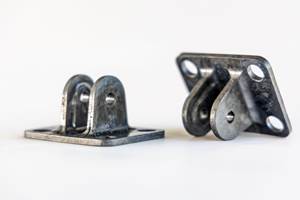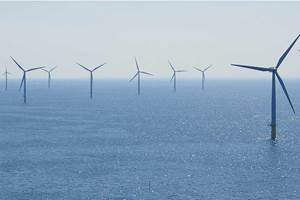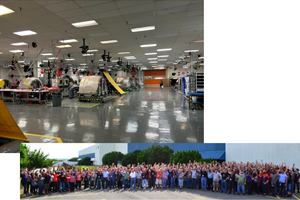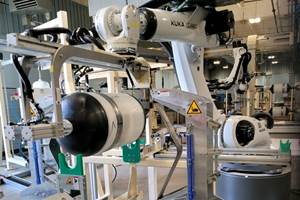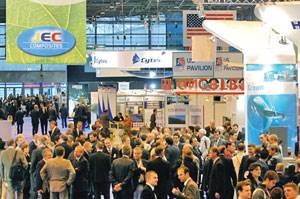JEC COMPOSITES 2008 show review
Composites professionals converged on this annual Parisian gathering in greater numbers than ever before, confident that the market’s global growth will continue.
At the 2008 edition of JEC COMPOSITES Show, held April 1-3 at the Paris Expo in Porte de Versaille, Paris, France, an increasingly global group of composites industry representatives had exchanged the generally upbeat mood seen at the 2007 show for one of confidence, both in the current business climate and in their expectations for future growth. In the months leading up to the show, composites manufacturers and their suppliers were no longer hoping for orders, they’re spending — on new facilities, expanded capacity, mergers and acquisitions and new product development — to meet delivery schedules.
The industry’s good fortune was clearly reflected in the numbers: Show organizers reported that a record total of 27,000 industry professionals from 96 nations were on hand for all or part of the three-day event. The JEC Group released market research figures that show a strong surge in the use of a number of materials, including both thermoplastic and thermoset resins, to this point in the decade. Reportedly, demand for thermoplastics has grown 8 percent per year while thermoset demand has increased at an annual rate of 5 percent. As a result, thermoplastics now hold a 35 percent share of the overall composite resins market, while thermosets have declined to a 65 percent share from 75 percent.
A standout in the JEC’s Forum series was a presentation by M. Stephen Tsai, Prof. Research Emeritus, Stanford University (Palo Alto, Calif.) at the Aeronautics Forum that introduced the new Micromechanics of Failure (MMF) computer analysis program. MMF offers new failure criteria for composite materials. According to Tsai, the basic difference between MMF and existing FEA programs is that the user doesn’t have to guess at process parameters — commonly referred to as “knock-down factors” — but instead enters calculated time, temperature and frequency data into the program. “Fatigue life predictions are better because of these parameters,” Tsai said, especially for quasi-isotropic laminates. Tsai acknowledged that alignment and other manufacturing variations are difficult to account for, but contends that these are mitigated by the consistent framework established by MMF. Master curves are being generated by several organizations around the world through cooperative research. For further information, E-mail: stsai@stanford.edu or visit the Web site: www.stanford.edu/group/composites/.
On the show floor
In the Paris Expo hall, JEC reports that 1,053 exhibitors had displays on the event’s largest-ever 43,500m² (468,230 ft²) show floor. HPC staffers were on hand, reporting the following new developments.
On display at the ABB France, Robotics Div. (Saint-Ouen l’Aumone, France) stand was a new robotic system, IRB6660, for cutting and machining carbon and glass fiber-reinforced plastics, which was said to be competitive with CNC cutters at one-half to one-third the cost.
Advanced Composites Group Ltd. (ACG, Heanor, Derbyshire, U.K.) displayed the DForm Deformable Composite System Technology for tooling. The latter is an aligned discontinuous fiber prepreg material made with 48-inch/1,200-mm wide unidirectional tape that is selectively slit in a discrete pattern, with the slits at a 45° angle to the axis of the tape. Each slit or cut is approximately 50 mm/2 inches long, effectively creating a web of discontinuous fibers. This construction permits the prepreg to better conform to mold contours, avoiding wrinkles and improving drapability.
Distributor Aero Consultants Ltd. AG (Nänikon-Uster, Switzerland) demonstrated its new ceramic tools, including the X-Drill bit and CeraCut Router, in cooperation with Advanced Ceramics Research Inc. (Tucson, Ariz). The new tools, designed to cut both carbon fiber- and glass fiber-reinforced composites and other nonmetallic materials, are reportedly harder than comparable carbide tools and have a longer wear life.
AGY Holdings LLC (Aiken, S.C.) unveiled a new S-Series range of glass fiber products that complement the company’s original high-performance S-2 Glass. Of interest to the advanced composites market is S-3 Glass, a “special” grade of product targeted to aerospace applications. Said to exhibit at least 20 percent higher modulus than the company’s S-2 fiber, S-3 is intended for niche applications: The fiber reportedly can be custom-engineered and manufactured in relatively low volumes, thanks to “modular” minifurnaces built since 2006 to expand AGY’s capacity. For the military vehicle armor market, the company introduced two new glass fibers: Featherlight glass fibers are designed for ultrahigh-performance threat levels, providing 5 percent to 10 percent better protection than AGY’s standard S-2 Glass fiber in composite armor. Quicksilver glass fibers are designed to provide significantly stronger, stiffer and lighter composite parts than traditional E-glass reinforcements. They are designed to be a cost-effective solution where weight is deemed to be less of a concern.
Airtech Europe SA (Differdange, Luxembourg) brought to JEC its new Dahlar Release Bag 460 LFT-G, a small-bore tubular film product developed for the manufacture of high-performance hollow parts. “LFT-G” stands for lay-flat tubing gusseted. The bag is a multilayer construction that combines a vacuum bag film with a release film to provide a single product with high-vacuum performance that will remove easily from within cured tubular composite laminates (see photo #4). The company says the product’s gusseted design makes it easier to position in hollow parts than traditional lay-flat bag material: Under pressure, the bag tubing will expand to fit the internal shape of the tubular part. Suitable part applications include bicycle components, yacht masts and other hollow products. Bag diameters range from 2 inches to 22 inches (50 mm to 560 mm) in lengths up to 15 ft/4.5m.
AKSA (Akrilic Kimya Sanayii AS, Istanbul, Turkey) highlighted its projected production of AKSACA 6K, 12K and 24K carbon fiber, made from its apparel-grade acrylic-based precursor. Initially, the company will produce 34 metric tonnes (about 75,000 lb) per year, which will increase to 1,500 metric tonnes (3.3 million lb) by the third quarter of 2009. Projected performance is 33.4 Msi (230,285 MPa) tensile modulus and 696 ksi (4,798 MPa) tensile strength.
Automated Dynamics (Schenectady, N.Y.) displayed photos of and information about its new articulated arm robot for automated fiber placement and tape laying in both R&D and production settings. Company personnel reported a highly positive response to this reportedly affordable and flexible approach to advanced composites manufacturing.
Axel Plastics Research Laboratories Inc. (Woodside, N.Y.) showed several new mold release products. MoldWiz 985JB is a concentrated water-based mold release designed to reduce hazardous volatile emissions in SMC/BMC molding operations. It’s said to be an easy-wetting, quick-drying solution that is 36 percent active and dilutable with tap water. Also new is a water-based XTEND release system for wind blade production, comprising a water-based mold sealer, WS-47, and a matte finish mold release, W-7838D. Both are recommended for spray application on either ambient or heated tools for multiple releases of epoxy or polyester parts. MoldWiz WB-2700, a new, silicone-free water-based mold release that comprises fatty acids, polyolefins and surfactants, is designed for compression molding and resin transfer molding (RTM) of polyester, vinyl ester and epoxy parts, as well as filament winding. XTEND 840, a new solvent-based semipermanent release, is said to provide gloss and durability for RTM, with surface tension suitable for gel-coated “A” sides in RTM molding, but chemical resistance and release performance sufficient for “B” sides and nongel-coated parts.
Axson Technologies (Cergy, France) showed a number of new products. Among them was Epolam 2090 high-temperature epoxy resin, offered in combination with the company’s GC1 gel coat in a new infusion system that benefits from the resin’s low viscosity and the gel coat’s resistance to high temperatures. Also new was LAB 970, a machinable epoxy slab used to fabricate models or molds with high surface finish for low-temperature prepreg systems; and a mass casting technology used to produce models and parts quickly and as close to final form as possible. Several rapid prototyping resins also were on display.
Celanese Emulsion Polymers (Dallas, Texas) introduced Vinamul 8868, a vinyl acetate emulsion for sizing application on direct roving. This functionalized polymer dispersion is compatible with epoxy resins and dispersions and can be added at loadings in the 50 to 70 percent range. The emulsion is said to have a fine particle size and compatibility with sizing additives, such as organosilanes and lubricants. The company reported good results in tests of tension and elongation in molded products made with rovings that incorporate the sizing, particularly in filament winding applications.
Cogemoule (Bellignat, France), a well-known, 40-year-old European tool and mold producer, touted its toolmaking services for injection molding, rotational molding and gravity casting as well as its expertise in the construction of composite tools. The company reported its recent purchase of a new 5-axis, high-speed machining center, capable of machining composites, aluminum and steel.
Cotech Inc. (San-gan, Taichung, Taiwan, R.O.C.), an integrator of composites technology into electrical and communications applications, such as computer notebooks and Bluetooth wireless phones, showcased several of its recently completed projects. Notable were a composite high-frequency radio wave antenna for an atmospheric research observatory in Mauna Loa, Hawaii, and several ablative and aerospace applications. Products are engineered and manufactured in Taiwan, according to company founder and president Ching-Long Ong.
Cytec Engineered Materials Inc.’s (Tempe, Ariz.) stand showcased a rear pressure bulkhead fabricated using a new version of the company’s PRIFORM material. Developed to enable infusion of preforms with toughened epoxy, standard PRIFORM incorporates the thermoplastic toughening agent usually formulated into the epoxy resin: The thermoplastic is spun into fibers and woven into the fiber form. New Veil Non-Crimped Fabric (VNCF), however, incorporates the toughening agent as a hot-blown soluble veil, which can be interleaved with carbon or other fiber tape reinforcements to form a nonwoven and, therefore, noncrimp fabric. As with the standard version of PRIFORM, resin infusion can take place using an untoughened Cytec epoxy resin designed with a viscosity low enough to facilitate fiber wetout. During cure processing, the veil dissolves and intermixes with the epoxy resin matrix, providing the toughening component that lends the matrix its desired impact-resistant properties.
A newcomer on the world stage, first-time JEC exhibitor Dalian Xingke Carbon Fiber Co. (Dalian City, China) is also the first Chinese enterprise to successfully commercialize carbon fiber. The company announced that it has boosted fiber production from its startup capacity of about 794,000 lb (360 metric tonnes) per year in 2003 to between 1.32 million lb and 1.76 million lb (600 and 800 metric tonnes) today.
DIAB (Laholm, Sweden) highlighted its many customer applications and spotlighted its expansion of DIAB Technologies, the group within the company that works with customers to provide laminate design, process optimization, training, testing and auditing. New products on the stand included GS 60, a new grid-scored, conformable foam core material with larger grids (60-mm/2.4-inch square vs. the standard 30-mm/1.2-inch square grid). Recommended for moderately curved or flat mold surfaces, the material reduces resin use by up to 50 percent, says the company. Also on display: Divinycell HP, a high-temperature foam core compatible with prepreg layup.
Dow Epoxy Systems (Midland, Mich.) introduced its new trademarked AIRSTONE resin systems for the wind energy market, available both in Europe and in the U.S. This family of products includes resins for infusion, hand layup, tooling and adhesives. Multiple product grades allow customers to tailor their final products. According to the company, the products have been developed from proven epoxy chemistry and technologies and are formulated to make wind turbine blades stronger, yet reduce overall blade weight.
Epsilon Pultrusion, a division of Epsilon Composite (Gaillan en Medoc, France), described its know-how in pultrusion and pullwinding of carbon fiber profiles and tubes. The company is in the process of doubling its manufacturing capacity, from 230 metric tonnes per year to 500 metric tonnes (507,000 lb to 1.1 million lb) and expects to have 20 production lines in place by 2010.
Design and manufacturing simulation software provider ESI Group (Paris, France) announced its partnership with ITOOL, a European project coordinated by EADS Innovation Works (Munich, Germany), which provides an integrated simulation software tool for dry-fiber textile preforming technologies. ITOOL virtual-manufacturing simulation in-corporates preform construction, draping and impregnation, followed by prediction of mechanical performance of the manufactured part. The company also announced the release of the 2008 version of its PAM-RTM (resin transfer molding) simulation tool, a software application for manufacturing composites by injection or infusion. The software is used primarily when complex and large composite parts are required for aeronautics, automotive, marine and energy applications.
Evonik Röhm GmbH (Darmstadt, Germany) promoted its numerical finite element analysis (FEA) services, offered to its customers to help them optimize cored sandwich structures and then analyze the cored parts’ mechanical, thermal and buckling behavior. The company also can premachine, preshape and kit foam cores to enable more efficient part production. The company’s well-known ROHACELL polymethacrylimide (PMI) foam core is used by Airbus in the cocured A-stringers used to stiffen A340-600 and A380 rear pressure bulkheads.
fibertech composites GmbH (Bremen, Germany) demonstrated its fibertemp electrically heated carbon mold technology, which uses the conductivity of the carbon fiber to heat the mold face. The company claims a 90 percent energy savings over conventionally heated molds.
Fibertex A/S (Aalborg, Denmark) exhibited its range of nonwovens, including its Compoflex product, a breathable peel ply layer that can replace breather/bleeder, release film and peel ply in a vacuum bagged layup.
FORCE Technology (Broendby, Denmark) displayed its portable, handheld ultrasonic device for onsite nondestructive testing (NDT) of thick parts. Product manager Morgan Troedsson said the portable scanner is designed to detect variations in fiber orientation (waviness, wrinkles) as well as voids and delaminations in solid composite parts up to 6 inches/152 mm thick. It is particularly valuable for onsite inspection of installed wind turbine rotor blades because the blade can be inspected without removing it from the rotor. The device, which operates with water as a coupling medium, also has been used in various aircraft and marine part inspections, Troedsson said. The company also makes fully automated NDT scanner systems — with real-time 3-D presentation on a video graph for surveying larger areas — as well as a range of P-scan NDT equipment.
Formosa Plastics Corp. (Taipei, Taiwan, R.O.C.) had a large booth with many visitors. Company representatives freely discussed carbon fiber production expansion plans. The company currently operates four production lines, capable of outputting a total of about 4,000 metric tonnes (8.82 million lb) of fiber. One new line will be added this year, with another in 2009. Production from the six lines is predicted to top 10,000 metric tonnes (22.05 million lb) in 2010.
George Sahm GmbH & Co. KG (Eschwege, Germany), a first-time JEC exhibitor, showed its new 850XE Sahm Carbonstar automatic filament winder for production of carbon fiber-reinforced polymer structures. The automated machine is designed to collect tows from the processing line, accurately meter the tow lengths and then create specific winding patterns. The machine has the ability to change patterns on the fly, says the company.
Grignard Co. LLC (Newark, N.J.) introduced Mandrel Magic, a new mold release agent, in gel or spray form, for filament winding mandrels. The nontoxic, water-based release is compatible with most resins, including epoxy and polyester. The new product joins the company’s family of solvent- and water-based releases for other process applications, including Mold Magic, a combination of carnauba wax and semipermanent release chemistries, and Release-It semipermanent and water-based semipermanent release systems.
Gurit (Wattwil, Switzerland) came to the show with a host of new products. SparPreg is a unidirectional (UD) prepreg for use in thick laminate sections. Targeted primarily to wind turbine rotor blade production, the material’s breathability is said to produce high-quality laminates with low void content, without the need for intermediate debulking or additional dry fabric reinforcement to aid air removal. WE91LE is a new variant in the WE91 range that offers lower exotherm, no intermediate dwell and, thus, reduced cycle times. It can be cured at temperatures as low as 85°C/185°F and also can be used for rapid manufacture via its 65-minute cure at 120°C/248°F. It has an outlife of 60 days at 21°C/70°F. For marine applications, new SP540 PB and SP540 LV high-performance modified epoxy adhesives have working times of up to six hours for bonding large production boats. New T-Paste 70-1 marine tooling paste can be used with a range of mixing machines and has been formulated to provide good application and CNC machining properties. It is complemented by a T-Paste 70-1 repair product, which provides seamless repair and the same performance for patterns produced using the original paste. Also new is Ampreg 21 epoxy, optimized for wet lamination of large composite structures using hand layup and vacuum bagging. Its relatively low initial mixed viscosity reportedly enables easy wetout of heavyweight reinforcements. New fire retardant systems in ST70 FR SPRINT and Ampreg 21 FR offer flammability protection for hot-melt and wet laminating processes respectively, conforming to UL94 and BS 476 Part 6 & 7 safety standards.
Henkel Corp. Aerospace (Bay Point, Calif. and Toulouse, France) launched at JEC Epsilon 99100, a benzoxazine RTM/VARTM resin system, optimized for aerospace applications and offered as an alternative to epoxy. The resin, says Henkel, enhances mechanical performance and durability while reducing the costs associated with composite structure during manufacture and service. It is stable at ambient temperatures for more than a year as a one-part resin. Other features include a long injection window suitable for large parts, low heat release during cure, low cure shrinkage, fire retardance suitable for aircraft fuselage and interior applications, high hot/wet property retention and good UV and thermal resistance. Cure temperature is 180°C/356°F.
Hexcel (Dublin, Calif. and Duxford, Cambridge, U.K.) celebrated its 60th anniversary at the show, highlighting the opening of three new plants: a production facility for aerospace prepreg in Nantes, France; a new carbon fiber facility in Spain; and an industrial prepreg manufacturing center in Tianjin, China, the latter to serve the wind energy market. A plethora of applications and products were on display, including Redux 870, a new two-component liquid shim adhesive; fast-curing HexPly M19 prepreg for wind blades; and HexPly XF3 surfacing film for Class A finishes on molded composite automotive body panels.
Huntsman Advanced Materials (The Woodlands, Texas) focused on auto racing at its stand, featuring a COURAGE ORECA LC70 Le Mans Series prototype developed by Hugues de Chaunac’s ORECA race team. The car’s body was developed using Huntsman’s RenShape rapid prototyping materials and Araldite resin infusion systems and adhesive products. Also on display for aerospace: resin infusion systems for making large-scale, high-temperature molds, including trademarked Araldite LY 8615, Aradur 8615 and Aradur 5212. The company also publicized its recent recognition for environmental efforts, having received the first European Green Production Innovation of the Year Award presented by Frost & Sullivan. The company’s Azyral high-performance laminating materials were particularly cited for their environmentally friendly characteristics.
Ingersoll Machine Tools Inc. (Rockford, Ill.) released a new version of its Integrated Composite Programming System (iCPS) for use on all of the company’s automated fiber placement systems. Emphasized in the new version is technology that provides real-time inspection of the carbon fiber tows. The technology uses a set of sensors, a local electronic data processor and proprietary software integrated with iCPS that checks for possible defects in tows before they’re laid down. It verifies tow presence, tow feeding, tow twist, tow folding, splice points, spool ending, late/early cut and late/early add. Ply data from this analysis is stored for reference after the fact if repairs are warranted.
New on the composites scene was ISOMATEX SA (Gembloux, Belgium), which introduced FILAVA basalt fibers. The company says the fibers feature high stiffness and good chemical resistance, with a functional temperature range of -260°C/-436°F to 720°C/1328°F. The density of the material is 2.56 g/cm³, and it is reportedly resistant to moisture and infrared rays. The company is marketing the basalt fibers as an alternative to glass, aramid and carbon fibers.
Kaneka Corp. (Toyko, Japan, Westerlo-Oevel, Belgium and Houston, Texas) displayed its core shell rubber (CSR) toughening system for epoxy resins. Predispersed in epoxy resin, the Kane AceMX toughener disperses better than powdered alternatives, thus providing for easier mixing.
Lectra (Paris, France) showcased its suite of cutting solutions for single-ply, low-volume prepreg materials and high-volume multilayer cutting of dry reinforcement fabrics made from glass fiber, aramid fiber and/or carbon fiber. The company claims to be the only cutting solutions provider that can supply machinery based on drag-knife, wheel, laser and oscillating-knife technologies. Also on offer was the newest VectorTechTexFX system, said to be suited to cutting a wider variety of materials. The system is designed to handle prepregged carbon fabric and multilayer dry fabrics, such as fiberglass, and reportedly can cut some core materials, such as phenolic honeycomb. Also on display was DesignConcept 3D, a multifunctional design tool that assists the user in creation of complex models, performance of feasibility analyses, cost estimation, and conversion (flattening) of 3-D shapes to 2-D images for cutting purposes.
Lindau Chemicals Inc. (Columbia, S.C.) had on display its LINDRIDE range of liquid anhydride curing agents for epoxy resins. The company offers a high-Tg curing agent for epoxy resins that are used in pultrusion, which is adapted to the process’ shorter cure cycle, says the company.
MF Tech Srl (Argentan, France), a builder of filament winding machines based on robotic technology and controlled with CADWIND software from MATERIAL SA (Zaventum/Brussels, Belgium), attracted a good deal of attention and high visitor traffic with a new articulated robotic arm. Designed for automated manufacturing lines, the 6-axis robot handles the part being produced, while a stationary creel or other device holds tow or roving.
MAG Cincinnati (Hebron, Ky.), already well known as a manufacturer of relatively large automatic tape layers (ATL) and automatic fiber placement (AFP) machines, introduced its new Small Flat Tape Layer (SFTL) as part of the CHARGER Series of ATLs. Designed for the manufacture of long, narrow, flat parts, nested multipart laminates and drape-formed components, the compact system is reportedly suitable for fabrication of aerospace spars, stringers, beams, ply packs, shear ties, frames, flaps and skins. There are two models, one that produces laminates up to 1.2m (47 inches) wide and another that produces laminates up to 2.5m (100 inches) wide. Each is equipped with the CM100 computer control and ACES (Advanced Composites Environment Suite) programming and simulation software. The latter is a PC-based tool compatible with CATIA V4 and V5, CATIA CWB/CD3 and FiberSIM.
Nanjing Fiberglass Research & Design Institute of Sinoma Science & Technology Co. Ltd. (Nanjing, China) produces S-glass, E-glass and radar-transparent D-glass, for which PPG Industries (Pittsburgh, Pa.) is the exclusive distributor in North America. PPG and Sinoma announced a 50/50 joint venture in 2005 for manufacturing fiberglass reinforcements. In January 2008, the joint venture, known as PPG Sinoma Jinjing Fiber Glass Co. Ltd., approved the addition of a third furnace at its manufacturing site in Zibo, China. Startup of the third furnace is projected for the end of this year or early 2009 and is expected to add 60,000 metric tonnes (132.3 million lb) of single-end roving production capacity annually.
Nanoledge (Clapiers, France) an-nounced a long-term collaboration with SKY-FLEX, the Composites Division of SK Chemicals Group (Seoul, Korea), to develop and market in Asia a nanofilled prepreg for high-performance sporting goods applications. Nanoledge will provide expertise on nanoparticles integration into thermosetting polymers while SKY-FLEX will provide know-how in high-performance prepreg manufacturing in sporting goods applications. The company is targeting potential product applications, including fishing rods, golf shafts, bike frames, arrows, ski poles, racquets, bats and sailing parts.
First-time JEC exhibitor Promak Srl (Collecorvino, Italy) exhibited its 2-D and 3-D numerically controlled cutting machines. On display was the F3A Easytop 2-D machining center with vacuum top. The company offers 3-, 4- and 5-axis machines with working surfaces of up to 12,000 mm² (18.6 in²) and can handle composite materials, plastics and other lightweight metals.
Related Content
9T Labs, Purdue University to advance composites use in structural aerospace applications
Partnership defines new standard of accessibility to produce 3D-printed structural composite parts as easily as metal alternatives via Additive Fusion Technology, workflow tools.
Read MoreUniversity of Sheffield researchers to drive structural health monitoring in U.K. infrastructure
The £7.7 million program, ROSEHIPS, anticipates exploitation of machine learning, sensing and digital twin technology for automated health monitoring in infrastructure, such as bridges, telecoms masts and wind turbines.
Read MoreCreating a culture of excellence in aerocomposites
ST Engineering MRAS discusses the importance of addressing human factors to reduce separator inclusion in bonded structures.
Read MoreAutomated filament winding system increases throughput, reduces manual labor for pressurized well tank production
For its new line of composite well water tanks, Amtrol worked with Roth Composite Machinery on an automated process for faster, more easily tracked production.
Read MoreRead Next
JEC COMPOSITES Show highlights
The annual gathering in Paris reflects the industry’s confidence that the market’s global growth will continue.
Read MoreFrom the CW Archives: The tale of the thermoplastic cryotank
In 2006, guest columnist Bob Hartunian related the story of his efforts two decades prior, while at McDonnell Douglas, to develop a thermoplastic composite crytank for hydrogen storage. He learned a lot of lessons.
Read MoreCW’s 2024 Top Shops survey offers new approach to benchmarking
Respondents that complete the survey by April 30, 2024, have the chance to be recognized as an honoree.
Read More
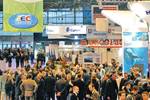















.jpg;maxWidth=300;quality=90)





